Crossing Over on the Piano
Home » Piano Technique » Crossing Over on Piano
Crossing 2 over 1
Crossing over is an important trick that makes it easy to play 6 notes with 5 fingers while playing smoothly ( Legato). The idea is to be able to expand our musical lines beyond the five fingers hand position when we play melodies and/or bass lines in the left hand.
We're going to perform a crossing over in following manner: We're about to place cross our 2nd finger above the 1st finger. We'll make sure the we keep the wrist high, loose and straight.
We'll try to avoid twisting the hand when crossing over because we try to perform as less movements as needed when we play piano.
Less moving means keeping more energy that goes to musical interpretation and other important elements.
The idea is the a movement should be made only if we can hear how it effects the sound.
Try to play the next exercise by crossing over the 2nd finger over the first and remember to work slowly. Be aware of how that you keep your wrist straight.
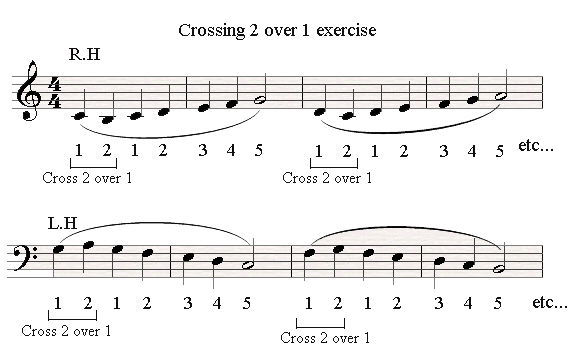
Here's an example of a piece with crossing over in the Pathetique Symphony by Tchaiskovsky.
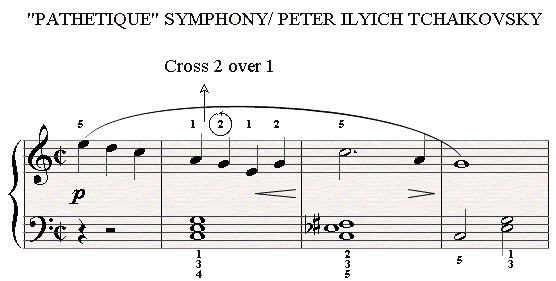
| The Exercise | Pdf File | Mp3 File |
| 1. Crossing 2 over 1 exercise 1 | Download | |
| 2. Crossing 2 over 1 exercise 2 | Download | |
| 3. Crossing 2 over 1 exercise 3 | Download | |
| 4. Crossing 2 over 1 exercise 4 | Download | |
| 5. Crossing 2 over 1 exercise - London Bridge | Download | |
| 6. Crossing 2 over 1 exercise - Boogie | Download |
Passing 1 Under 2
Passing under is another trick that helps us to play 7 notes with 5 finger by passing the 1st finger under the 2nd.
The wrist should be kept loose high and quiet as well. Remember that less movement means more concentration.
Here's a handy exercise that involves a crossing over. Remember to work slowly and be aware of the movement you're making.


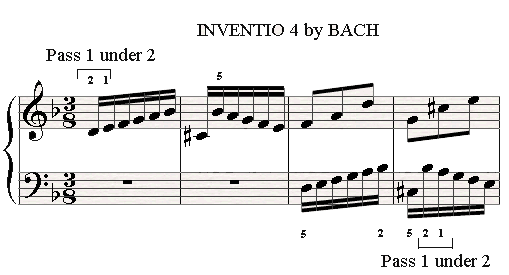
And here's a great example that shows how passing 1 under 2 is perofrmed in the 4th invention by Bach.
Crossing 3 over 1
Playing scales and scale like phrases - cross 3 over 1
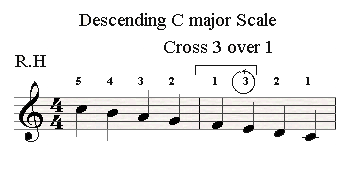
Let's take
the C major scale
and play it in an descending manner.
We start with the fifth finger on the upper C, and then we descend until we
reach the F note with the first finger, then what?
In order to move to the E note we can simply cross over the third finger above the thumb while keeping the wrist high and straight.
What we actually did was moving from the F position to a C position.
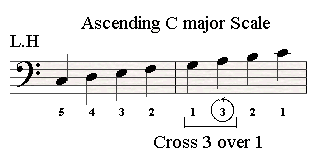
We can do the same by playing an ascending scale in the left hand.
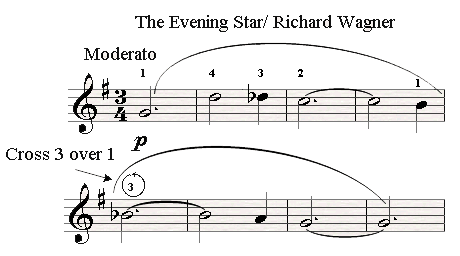 Here's an example of a piece perform with the cross 3 over 1.
Here's an example of a piece perform with the cross 3 over 1.
For more info on practising piano scales with the cross over check this page on practising piano scales.
Passing 1 Under 3
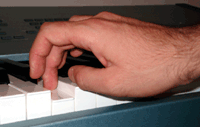 The cross over is the action we take when we switch our thumb under the third
finger after the first set of fingering in our exercise (1 - 2 - 3).
The cross over is the action we take when we switch our thumb under the third
finger after the first set of fingering in our exercise (1 - 2 - 3).
By passing the first finger under the third, we should be able to play 8 notes with 5 fingers. This will help us to play a complete scale with either hand, ascending and descending.
Here are again some important guidelines:
- Begin very slowly
- Keep the wrist loose and quiet
- After playing the first note of the scale carry the thumb at the based of the 3rd and 4th fingers
- Drop the thumb on the outside tip of the nail


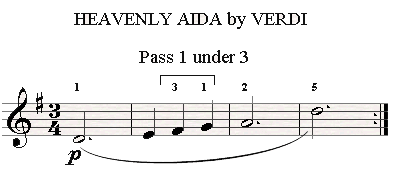
Here's an example of how we could use the passing 1 under 3 in heavenly Aide by Guiseppe Verdi. In this piece we basically switch the hand position for D position to G position.
Return from Crossing Over on Piano to Piano Technique














